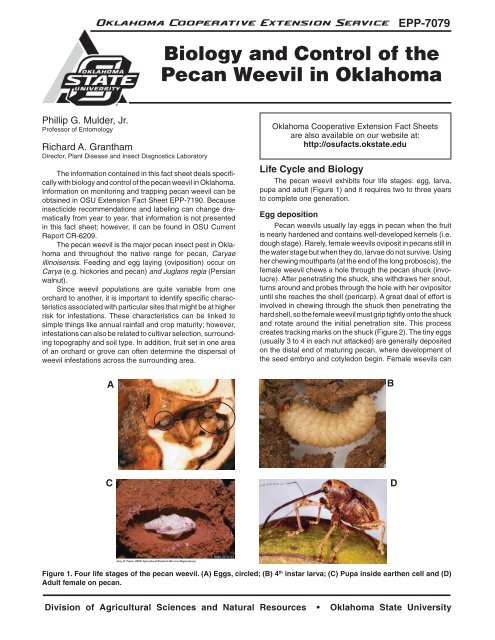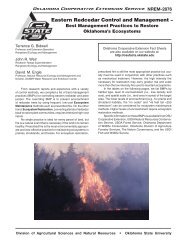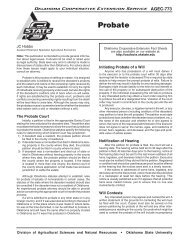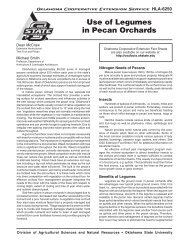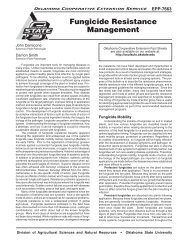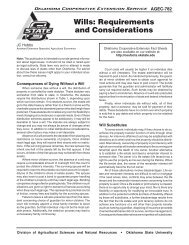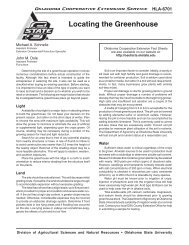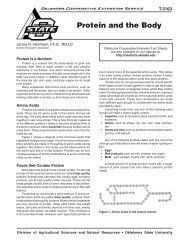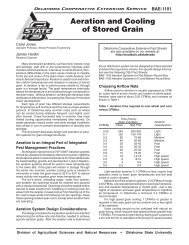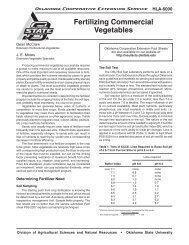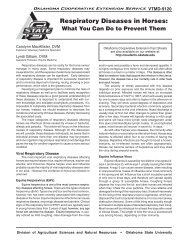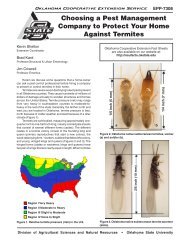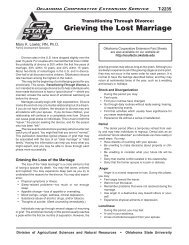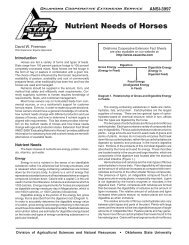Biology and Control of the Pecan Weevil in Oklahoma - OSU Fact ...
Biology and Control of the Pecan Weevil in Oklahoma - OSU Fact ...
Biology and Control of the Pecan Weevil in Oklahoma - OSU Fact ...
Create successful ePaper yourself
Turn your PDF publications into a flip-book with our unique Google optimized e-Paper software.
<strong>Oklahoma</strong> Cooperative Extension Service<br />
EPP-7079<br />
<strong>Biology</strong> <strong>and</strong> <strong>Control</strong> <strong>of</strong> <strong>the</strong><br />
<strong>Pecan</strong> <strong>Weevil</strong> <strong>in</strong> <strong>Oklahoma</strong><br />
Phillip G. Mulder, Jr.<br />
Pr<strong>of</strong>essor <strong>of</strong> Entomology<br />
Richard A. Grantham<br />
Director, Plant Disease <strong>and</strong> Insect Diagnostics Laboratory<br />
The <strong>in</strong>formation conta<strong>in</strong>ed <strong>in</strong> this fact sheet deals specifically<br />
with biology <strong>and</strong> control <strong>of</strong> <strong>the</strong> pecan weevil <strong>in</strong> <strong>Oklahoma</strong>.<br />
Information on monitor<strong>in</strong>g <strong>and</strong> trapp<strong>in</strong>g pecan weevil can be<br />
obta<strong>in</strong>ed <strong>in</strong> <strong>OSU</strong> Extension <strong>Fact</strong> Sheet EPP-7190. Because<br />
<strong>in</strong>secticide recommendations <strong>and</strong> label<strong>in</strong>g can change dramatically<br />
from year to year, that <strong>in</strong>formation is not presented<br />
<strong>in</strong> this fact sheet; however, it can be found <strong>in</strong> <strong>OSU</strong> Current<br />
Report CR-6209.<br />
The pecan weevil is <strong>the</strong> major pecan <strong>in</strong>sect pest <strong>in</strong> <strong>Oklahoma</strong><br />
<strong>and</strong> throughout <strong>the</strong> native range for pecan, Caryae<br />
ill<strong>in</strong>oisensis. Feed<strong>in</strong>g <strong>and</strong> egg lay<strong>in</strong>g (oviposition) occur on<br />
Carya (e.g. hickories <strong>and</strong> pecan) <strong>and</strong> Juglans regia (Persian<br />
walnut).<br />
S<strong>in</strong>ce weevil populations are quite variable from one<br />
orchard to ano<strong>the</strong>r, it is important to identify specific characteristics<br />
associated with particular sites that might be at higher<br />
risk for <strong>in</strong>festations. These characteristics can be l<strong>in</strong>ked to<br />
simple th<strong>in</strong>gs like annual ra<strong>in</strong>fall <strong>and</strong> crop maturity; however,<br />
<strong>in</strong>festations can also be related to cultivar selection, surround<strong>in</strong>g<br />
topography <strong>and</strong> soil type. In addition, fruit set <strong>in</strong> one area<br />
<strong>of</strong> an orchard or grove can <strong>of</strong>ten determ<strong>in</strong>e <strong>the</strong> dispersal <strong>of</strong><br />
weevil <strong>in</strong>festations across <strong>the</strong> surround<strong>in</strong>g area.<br />
<strong>Oklahoma</strong> Cooperative Extension <strong>Fact</strong> Sheets<br />
are also available on our website at:<br />
http://osufacts.okstate.edu<br />
Life Cycle <strong>and</strong> <strong>Biology</strong><br />
The pecan weevil exhibits four life stages: egg, larva,<br />
pupa <strong>and</strong> adult (Figure 1) <strong>and</strong> it requires two to three years<br />
to complete one generation.<br />
Egg deposition<br />
<strong>Pecan</strong> weevils usually lay eggs <strong>in</strong> pecan when <strong>the</strong> fruit<br />
is nearly hardened <strong>and</strong> conta<strong>in</strong>s well-developed kernels (i.e.<br />
dough stage). Rarely, female weevils oviposit <strong>in</strong> pecans still <strong>in</strong><br />
<strong>the</strong> water stage but when <strong>the</strong>y do, larvae do not survive. Us<strong>in</strong>g<br />
her chew<strong>in</strong>g mouthparts (at <strong>the</strong> end <strong>of</strong> <strong>the</strong> long proboscis), <strong>the</strong><br />
female weevil chews a hole through <strong>the</strong> pecan shuck (<strong>in</strong>volucre).<br />
After penetrat<strong>in</strong>g <strong>the</strong> shuck, she withdraws her snout,<br />
turns around <strong>and</strong> probes through <strong>the</strong> hole with her ovipositor<br />
until she reaches <strong>the</strong> shell (pericarp). A great deal <strong>of</strong> effort is<br />
<strong>in</strong>volved <strong>in</strong> chew<strong>in</strong>g through <strong>the</strong> shuck <strong>the</strong>n penetrat<strong>in</strong>g <strong>the</strong><br />
hard shell, so <strong>the</strong> female weevil must grip tightly onto <strong>the</strong> shuck<br />
<strong>and</strong> rotate around <strong>the</strong> <strong>in</strong>itial penetration site. This process<br />
creates track<strong>in</strong>g marks on <strong>the</strong> shuck (Figure 2). The t<strong>in</strong>y eggs<br />
(usually 3 to 4 <strong>in</strong> each nut attacked) are generally deposited<br />
on <strong>the</strong> distal end <strong>of</strong> matur<strong>in</strong>g pecan, where development <strong>of</strong><br />
<strong>the</strong> seed embryo <strong>and</strong> cotyledon beg<strong>in</strong>. Female weevils can<br />
A<br />
B<br />
C<br />
D<br />
Figure 1. Four life stages <strong>of</strong> <strong>the</strong> pecan weevil. (A) Eggs, circled; (B) 4 th <strong>in</strong>star larva; (C) Pupa <strong>in</strong>side ear<strong>the</strong>n cell <strong>and</strong> (D)<br />
Adult female on pecan.<br />
Division <strong>of</strong> Agricultural Sciences <strong>and</strong> Natural Resources • <strong>Oklahoma</strong> State University
Figure 4. Fourth <strong>in</strong>star pecan weevil larva exit<strong>in</strong>g a nut.<br />
Figure 2. Track<strong>in</strong>g marks created by female weevil chew<strong>in</strong>g<br />
<strong>and</strong> drill<strong>in</strong>g ovipositor through <strong>the</strong> shuck <strong>and</strong> shell.<br />
extend <strong>the</strong>ir ovipositor <strong>in</strong>to various regions <strong>of</strong> <strong>the</strong> develop<strong>in</strong>g<br />
kernel (Figure 3). Egg hatch (eclosion) occurs with<strong>in</strong> six to<br />
14 days after deposition.<br />
Larval Description <strong>and</strong> Development<br />
Similar to many grubs, pecan weevils exhibit four larval<br />
<strong>in</strong>stars; however, while <strong>the</strong> first three average approximately<br />
13 days each <strong>in</strong> duration, <strong>the</strong> f<strong>in</strong>al <strong>in</strong>star may feed for five to<br />
n<strong>in</strong>e days, but will spend from one to two years <strong>in</strong> <strong>the</strong> soil,<br />
without feed<strong>in</strong>g. Dur<strong>in</strong>g that prolonged period, larvae (<strong>and</strong><br />
subsequently <strong>the</strong> pupa <strong>and</strong> pre-emergent adult) will have<br />
greater stores <strong>of</strong> fat body, undeveloped reproductive organs<br />
<strong>and</strong> an 8-fold decrease <strong>in</strong> oxygen consumption compared<br />
to active stages. This tells us that diapaus<strong>in</strong>g weevil larvae,<br />
pupae <strong>and</strong> adults are well protected, do not feed <strong>and</strong> can<br />
essentially “sip” oxygen to preserve <strong>the</strong>mselves <strong>and</strong> <strong>the</strong>ir air<br />
supply even under flood conditions. When fully grown, pecan<br />
weevil grubs have a creamy white body that is about ¾ <strong>in</strong>ch<br />
long with a reddish-brown head capsule (this is why <strong>the</strong>y were<br />
<strong>of</strong>ten referred to as redheads <strong>in</strong> older literature). After feed<strong>in</strong>g<br />
with<strong>in</strong> a nut, larvae will chew exit holes about 1/8 <strong>of</strong> an <strong>in</strong>ch <strong>in</strong><br />
diameter <strong>in</strong> <strong>the</strong> shell, emerge from <strong>the</strong> nuts, <strong>and</strong> drop to <strong>the</strong><br />
ground (Figure 4). Larvae will burrow <strong>in</strong>to <strong>the</strong> soil to various<br />
depths depend<strong>in</strong>g on <strong>the</strong> soil type <strong>and</strong> condition <strong>of</strong> <strong>the</strong> soil<br />
Figure 3. Female weevil with ovipositor extend<strong>in</strong>g through<br />
<strong>the</strong> shuck <strong>and</strong> <strong>in</strong>to <strong>the</strong> nut.<br />
where <strong>the</strong>y l<strong>and</strong>ed. Most larvae penetrate <strong>the</strong> soil to a depth<br />
<strong>of</strong> six to n<strong>in</strong>e <strong>in</strong>ches. Once <strong>the</strong>y have reached <strong>the</strong>ir f<strong>in</strong>al rest<strong>in</strong>g<br />
depth, larvae will construct a hard, almost impenetrable<br />
ear<strong>the</strong>n cell, where <strong>the</strong>y will rema<strong>in</strong> <strong>in</strong> diapause until <strong>the</strong>y<br />
pupate, molt to <strong>the</strong> adult stage, <strong>and</strong> ultimately emerge.<br />
Pupal Description <strong>and</strong> Development<br />
About 90 percent <strong>of</strong> <strong>the</strong> larvae that enter <strong>the</strong> soil <strong>the</strong><br />
first year after feed<strong>in</strong>g on pecans spend one year <strong>in</strong> <strong>the</strong> soil<br />
before pupat<strong>in</strong>g. The rema<strong>in</strong><strong>in</strong>g 10 percent will not pupate<br />
until <strong>the</strong> follow<strong>in</strong>g year. The pupal stage <strong>of</strong> <strong>the</strong> pecan weevil<br />
is a whitish, mummified-look<strong>in</strong>g version <strong>of</strong> <strong>the</strong> adult (exarate<br />
pupa; Figure 1C). The pupal stage lasts approximately three<br />
weeks (a little longer for females than males).<br />
Adult Description <strong>and</strong> Development<br />
After transformation from <strong>the</strong> pupal stage, adults will<br />
rema<strong>in</strong> <strong>in</strong>active with<strong>in</strong> <strong>the</strong> ear<strong>the</strong>n cell <strong>and</strong> do not attempt to<br />
emerge from <strong>the</strong> soil until August <strong>of</strong> <strong>the</strong> follow<strong>in</strong>g year. This<br />
makes <strong>the</strong> total time from first enter<strong>in</strong>g <strong>the</strong> soil as larvae to<br />
exit<strong>in</strong>g as adults approximately two (90 percent) or three (10<br />
percent) years. The adult pecan weevil is a light-brown to<br />
grayish snout beetle, measur<strong>in</strong>g about ½ <strong>in</strong>ch <strong>in</strong> body length<br />
(Figure 1). The snout <strong>of</strong> male pecan weevils is about half <strong>the</strong><br />
length <strong>of</strong> <strong>the</strong> female’s, <strong>and</strong> curves primarily at <strong>the</strong> tip. Antennae<br />
<strong>of</strong> <strong>the</strong> male also appear to attach to <strong>the</strong> snout half <strong>the</strong> distance<br />
from <strong>the</strong> face (Figure 5A). Female pecan weevils possess a<br />
longer snout, which curves gradually. Antennae <strong>of</strong> <strong>the</strong> female<br />
pecan weevil attach to <strong>the</strong> snout about 1/3 <strong>the</strong> distance from<br />
<strong>the</strong> face (Figure 5B). Two important events dictate <strong>the</strong> tim<strong>in</strong>g<br />
<strong>of</strong> pecan weevil emergence <strong>and</strong> damage on pecan <strong>in</strong>clud<strong>in</strong>g<br />
ra<strong>in</strong>fall <strong>and</strong> nut maturity. In <strong>Oklahoma</strong>, peak emergence <strong>of</strong><br />
weevils generally occurs from late August to mid-September;<br />
however, this tim<strong>in</strong>g can occur earlier or later depend<strong>in</strong>g on<br />
soil moisture. Typically, weevil emergence <strong>in</strong>creases three<br />
to four days after a 1- to 2-<strong>in</strong>ch ra<strong>in</strong>fall. Soil moisture alone;<br />
however, does not dictate weevil emergence <strong>and</strong> this <strong>in</strong>sect<br />
has evolved <strong>in</strong> <strong>the</strong> flood pla<strong>in</strong> environment for centuries with<br />
great success. Ano<strong>the</strong>r important cue that stimulates weevil<br />
emergence from <strong>the</strong> soil is nut maturity. While <strong>the</strong> pecan weevil<br />
cannot sense nut maturity from beneath <strong>the</strong> soils surface, this<br />
tim<strong>in</strong>g has been fixed through years <strong>of</strong> selection. Therefore,<br />
weevil success <strong>in</strong> propagat<strong>in</strong>g <strong>the</strong> species is closely tied to<br />
emerg<strong>in</strong>g when fruit are close to <strong>the</strong> dough stage <strong>of</strong> develop-<br />
EPP-7079-2
(B) Female<br />
(A) Male;<br />
Figure 5. <strong>Pecan</strong> weevil adults show<strong>in</strong>g <strong>in</strong>sertion po<strong>in</strong>t <strong>of</strong><br />
antennae on proboscis.<br />
ment. When drought conditions persist, weevil emergence is<br />
<strong>of</strong>ten delayed till late September or even October <strong>and</strong> <strong>in</strong> some<br />
years late population peaks have occurred dur<strong>in</strong>g this time.<br />
This susta<strong>in</strong>ed emergence pattern is exactly why trapp<strong>in</strong>g <strong>and</strong><br />
monitor<strong>in</strong>g for weevils until shuck split is important. Regardless<br />
<strong>of</strong> pecan type (native vs. improved cultivar), pecan weevils<br />
will beg<strong>in</strong> oviposit<strong>in</strong>g eggs sooner on earlier matur<strong>in</strong>g nuts.<br />
After emergence from <strong>the</strong> soil, pecan weevils enter <strong>the</strong> tree by<br />
ei<strong>the</strong>r crawl<strong>in</strong>g up <strong>the</strong> bole (tree trunk) or fly<strong>in</strong>g directly to <strong>the</strong><br />
canopy or trunk. Regardless <strong>of</strong> how <strong>the</strong>y eventually enter <strong>the</strong><br />
canopy, it appears that <strong>the</strong> majority <strong>of</strong> <strong>the</strong> weevil population<br />
orients to <strong>the</strong> pecan trunk (perhaps as much as 85 percent <strong>of</strong><br />
<strong>the</strong> emerg<strong>in</strong>g population). This expla<strong>in</strong>s why trunk traps (i.e.<br />
Circle traps) are more efficient at captur<strong>in</strong>g greater numbers <strong>of</strong><br />
weevils than o<strong>the</strong>r trap types. Once weevils enter <strong>the</strong> canopy<br />
<strong>and</strong> explore <strong>the</strong> environment for food <strong>and</strong> oviposition sites,<br />
if no pecans are found (due to alternate bear<strong>in</strong>g, common <strong>in</strong><br />
unmanaged, native pecan) weevils will fly to ano<strong>the</strong>r adjacent<br />
tree or emigrate from <strong>the</strong> orchard to more suitable areas.<br />
The average longevity <strong>of</strong> adult weevils is generally between<br />
15 to 30 days; however, female weevils emerg<strong>in</strong>g beneath<br />
large-seeded cultivars can live for up to 56 days. Generally,<br />
female pecan weevils live longer than males <strong>and</strong> those that<br />
emerge early <strong>in</strong> <strong>the</strong> season live longer than those that emerge<br />
later.<br />
Fruit Injury <strong>and</strong> Damage<br />
<strong>Pecan</strong> weevils cause different k<strong>in</strong>ds <strong>of</strong> damage, depend<strong>in</strong>g<br />
on <strong>the</strong> stage <strong>of</strong> fruit development at <strong>the</strong> time <strong>of</strong> attack:<br />
• Dropped <strong>and</strong> punctured nuts caused by adult weevils<br />
feed<strong>in</strong>g on <strong>the</strong> kernel <strong>in</strong> <strong>the</strong> water stage <strong>of</strong> pecan development.<br />
The amount <strong>of</strong> feed<strong>in</strong>g damage is directly related to<br />
population density, time <strong>of</strong> emergence, <strong>and</strong> longevity <strong>of</strong><br />
weevils. On average, <strong>in</strong>dividual male <strong>and</strong> female weevils<br />
destroy 0.23 <strong>and</strong> 0.29 nuts per day, respectively. Nuts<br />
punctured late <strong>in</strong> <strong>the</strong> season (after shell harden<strong>in</strong>g) <strong>of</strong>ten<br />
rema<strong>in</strong> green <strong>and</strong> adhere to <strong>the</strong> tree past normal harvest.<br />
Shallow feed<strong>in</strong>g by male weevils after shell harden<strong>in</strong>g may<br />
impart slight scarr<strong>in</strong>g on <strong>the</strong> shell but generally results <strong>in</strong><br />
no noticeable damage to <strong>the</strong> nut meat. Females feed<strong>in</strong>g<br />
through <strong>the</strong> kernel (cotyledon) on nuts after shell harden<strong>in</strong>g<br />
can cause degradation <strong>of</strong> <strong>the</strong> gel <strong>and</strong> “sticktights”<br />
or “pops” (smaller nuts with <strong>the</strong> shuck adhered to <strong>the</strong><br />
shell) may be formed (Figure 6a). If <strong>the</strong> kernel is simply<br />
probed by <strong>the</strong> female <strong>and</strong> not fully penetrated, <strong>the</strong>n black<br />
spots, pits, or molds can occur. These spots, similar to<br />
those created by st<strong>in</strong>k bugs feed<strong>in</strong>g on pecan late <strong>in</strong> <strong>the</strong><br />
season, can make each affected kernel taste bitter <strong>and</strong><br />
<strong>the</strong>reby decrease marketability (Figure 6b).<br />
• Larval feed<strong>in</strong>g with<strong>in</strong> partially matured nuts. The grubs<br />
feed on <strong>the</strong> kernels for several weeks. Damaged mature<br />
nuts do not drop, while <strong>the</strong> larvae cont<strong>in</strong>ue to feed with<strong>in</strong><br />
<strong>the</strong> nut. This causes <strong>the</strong> shuck to adhere to <strong>the</strong> shell. Two<br />
to four larvae with<strong>in</strong> each <strong>in</strong>fested nut easily destroys <strong>the</strong><br />
entire kernel (Figure 7).<br />
• Ovipositional damage. Each female weevil can oviposit<br />
30 to 54 eggs; <strong>the</strong>refore, one weevil could affect as many<br />
as 15 to 27 or as few as 7 to 13 pecans, assum<strong>in</strong>g <strong>the</strong>re<br />
are two to four larvae per nut, respectively. When kernel<br />
formation <strong>and</strong> expansion beg<strong>in</strong>s <strong>in</strong> <strong>the</strong> pecan (near <strong>the</strong><br />
end <strong>of</strong> August) adult weevils start seek<strong>in</strong>g oviposition sites.<br />
Oviposition has been observed as early as two days after<br />
emergence; however, <strong>the</strong> average preovipositional period<br />
is about 6.5 days. Peak egg production <strong>in</strong> pecan weevils<br />
is generally reached 10 to12 days after emergence. De-<br />
A<br />
B<br />
Figure 6. ‘Sticktights’ (A) are smaller nuts with <strong>the</strong> shuck<br />
adhered to <strong>the</strong> shell. Black spots (B) from pecan weevils<br />
feed<strong>in</strong>g on pecan kernels. (Photos courtesy Jerry Payne,<br />
USDA/ARS, Bugwood.org)<br />
EPP-7079-3
• You cannot adequately account for weevil immigration<br />
<strong>in</strong>to <strong>the</strong> orchard from adjacent unprotected orchards or<br />
native trees.<br />
Figure 7. <strong>Weevil</strong> larvae feed<strong>in</strong>g <strong>in</strong> a pecan nut.<br />
lays <strong>in</strong> mat<strong>in</strong>g, egg maturation <strong>and</strong> oviposition have been<br />
observed <strong>in</strong> late matur<strong>in</strong>g <strong>and</strong>/or large-seeded cultivars.<br />
Research suggests that female weevils place a possible<br />
marker pheromone that prevents multiple weevils from lay<strong>in</strong>g<br />
eggs <strong>in</strong> a s<strong>in</strong>gle nut; however, if <strong>in</strong>festations reach <strong>in</strong>credibly<br />
high levels (90 percent or more), <strong>and</strong> limited oviposition sites<br />
are available, <strong>the</strong>n multiple oviposition events may occur. Of<br />
course, <strong>the</strong> consequence <strong>of</strong> pecan weevil oviposition <strong>in</strong> pecan<br />
is an unmarketable product <strong>and</strong> cont<strong>in</strong>ued proliferation <strong>of</strong> <strong>the</strong><br />
population throughout <strong>the</strong> orchard.<br />
With this <strong>in</strong> m<strong>in</strong>d, it is important to underst<strong>and</strong> how <strong>the</strong><br />
weevil develops <strong>and</strong> makes its way to <strong>the</strong> pecan tree to see<br />
<strong>the</strong> importance <strong>of</strong> monitor<strong>in</strong>g <strong>and</strong> trapp<strong>in</strong>g. Complete recommendations<br />
on trapp<strong>in</strong>g pecan weevils can be obta<strong>in</strong>ed <strong>in</strong><br />
<strong>OSU</strong> Extension <strong>Fact</strong> Sheet EPP-7190. Once a threshold is<br />
reached <strong>in</strong> an orchard or grove, treatment should be applied<br />
with an airblast sprayer calibrated to deliver a m<strong>in</strong>imum <strong>of</strong><br />
100 gallons per acre (Figure 8). Airblast sprayers come <strong>in</strong><br />
a number <strong>of</strong> sizes. Larger sprayers can reach <strong>the</strong> tops <strong>of</strong><br />
trees <strong>in</strong> excess <strong>of</strong> 80 feet <strong>and</strong> provide excellent coverage<br />
to <strong>the</strong> entire canopy. Regardless <strong>of</strong> <strong>in</strong>secticide selected,<br />
multiple applications will likely be needed throughout <strong>the</strong><br />
weevil season, especially if nuts are marketed for retail sales.<br />
To ensure penetration <strong>and</strong> through coverage, commercial<br />
growers should be encouraged to treat both sides <strong>of</strong> each<br />
tree. Traditionally, <strong>in</strong>secticide choices for many growers that<br />
allow livestock to graze <strong>in</strong> <strong>the</strong>ir orchards were limited to Sev<strong>in</strong><br />
<strong>in</strong>secticide, which is still an effective <strong>and</strong> safe choice for most<br />
applicators. Because <strong>of</strong> <strong>in</strong>creas<strong>in</strong>g costs associated with this<br />
product, <strong>and</strong> excellent efficacy <strong>of</strong> some newer generation<br />
pyrethroids, this chemistry has become more common. For<br />
a complete list<strong>in</strong>g <strong>of</strong> <strong>in</strong>secticide recommendations on pecan,<br />
<strong>in</strong>clud<strong>in</strong>g <strong>in</strong>formation on fungicides to protect trees from scab<br />
<strong>in</strong>fection, consult <strong>OSU</strong> Current Report CR-6209. This publication<br />
is revised each year <strong>and</strong> conta<strong>in</strong>s detailed, current<br />
<strong>in</strong>formation on pesticide recommendations for pecan.<br />
<strong>Control</strong>l<strong>in</strong>g <strong>Weevil</strong> Populations<br />
S<strong>in</strong>ce most <strong>of</strong> <strong>the</strong> life stages <strong>of</strong> <strong>the</strong> pecan weevil <strong>in</strong>habit<br />
protected environments, applications used to control this pest<br />
are generally targeted at <strong>the</strong> adult stage. Many attempts<br />
have been made by <strong>in</strong>dependent researchers <strong>and</strong> <strong>in</strong>dustry<br />
representatives to control weevil larvae <strong>in</strong> <strong>the</strong> soil us<strong>in</strong>g an<br />
<strong>in</strong>secticide. Unfortunately, several factors have lead to <strong>the</strong><br />
failure <strong>of</strong> this approach <strong>in</strong>clud<strong>in</strong>g:<br />
• <strong>Weevil</strong>s are diapaus<strong>in</strong>g dur<strong>in</strong>g this phase <strong>of</strong> development.<br />
Therefore, very little respiratory or o<strong>the</strong>r physiological<br />
activity is occurr<strong>in</strong>g <strong>in</strong> this stage.<br />
• Penetration <strong>of</strong> an <strong>in</strong>secticide <strong>in</strong>to <strong>the</strong> soil pr<strong>of</strong>ile to a depth<br />
<strong>of</strong> 6 to 9 <strong>in</strong>ches would be a big challenge for any chemical.<br />
• <strong>Weevil</strong> larvae <strong>and</strong> even pre-emergent adults are well<br />
protected with<strong>in</strong> an almost impenetrable ear<strong>the</strong>n cell.<br />
• Attempts to time applications when adult weevils first<br />
exit <strong>the</strong> soil cannot be well timed because <strong>of</strong> <strong>the</strong> <strong>of</strong>ten<br />
prolonged emergence pattern exhibited by this species.<br />
Figure 8. Airblast sprayer used for treat<strong>in</strong>g pecan orchards<br />
for pecan weevil <strong>and</strong> o<strong>the</strong>r pests.<br />
<strong>Oklahoma</strong> State University, <strong>in</strong> compliance with Title VI <strong>and</strong> VII <strong>of</strong> <strong>the</strong> Civil Rights Act <strong>of</strong> 1964, Executive Order 11246 as amended, Title IX <strong>of</strong> <strong>the</strong> Education Amendments <strong>of</strong> 1972, Americans<br />
with Disabilities Act <strong>of</strong> 1990, <strong>and</strong> o<strong>the</strong>r federal laws <strong>and</strong> regulations, does not discrim<strong>in</strong>ate on <strong>the</strong> basis <strong>of</strong> race, color, national orig<strong>in</strong>, gender, age, religion, disability, or status as a veteran <strong>in</strong><br />
any <strong>of</strong> its policies, practices, or procedures. This <strong>in</strong>cludes but is not limited to admissions, employment, f<strong>in</strong>ancial aid, <strong>and</strong> educational services.<br />
Issued <strong>in</strong> fur<strong>the</strong>rance <strong>of</strong> Cooperative Extension work, acts <strong>of</strong> May 8 <strong>and</strong> June 30, 1914, <strong>in</strong> cooperation with <strong>the</strong> U.S. Department <strong>of</strong> Agriculture, <strong>the</strong> Director <strong>of</strong> Cooperative Extension Service,<br />
<strong>Oklahoma</strong> State University, Stillwater, <strong>Oklahoma</strong>. This publication is pr<strong>in</strong>ted <strong>and</strong> issued by <strong>Oklahoma</strong> State University as authorized by <strong>the</strong> Vice President, Dean, <strong>and</strong> Director <strong>of</strong> <strong>the</strong> Division <strong>of</strong><br />
Agricultural Sciences <strong>and</strong> Natural Resources <strong>and</strong> has been prepared <strong>and</strong> distributed at a cost <strong>of</strong> 20 cents per copy. 0413 Revised. GH.<br />
EPP-7079-4


